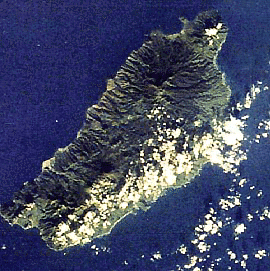|
 |
Volume No. 1 Issue No. 55 - Thursday February 05, 2004 |
The History of a Volcanic Island
 by Thomson Fontaine by Thomson Fontaine
 This volcanic imagery of Dominica taken by NASA astronauts from the space shuttle shows a country bursting with volcanic activity predominantly along the eastern part of the island. This volcanic imagery of Dominica taken by NASA astronauts from the space shuttle shows a country bursting with volcanic activity predominantly along the eastern part of the island.
 Dominica is part of the Lesser Antilles island arc that marks a convergent plate tectonic boundary between the Caribbean and Atlantic plates. The island consists mostly of breccias, domes, pyroclastic flows, and lavas derived and erupted from at least seven volcanic centers. Dominica is part of the Lesser Antilles island arc that marks a convergent plate tectonic boundary between the Caribbean and Atlantic plates. The island consists mostly of breccias, domes, pyroclastic flows, and lavas derived and erupted from at least seven volcanic centers.
Although there have been no historic eruptions on the island, there have been several tremors in the recent past, and Caribbean experts have forecast an eruption within the next hundred years. In 1880, there was a steam blast in the Valley of Desolation, and four areas with large sulfur deposits, including the Boiling Lake, remain active.
It was on this island that the country�s first inhabitants the Arawaks made their settlements during the late 13th and early 14th century. By the time Columbus landed on November 3, 1493, these peace loving inhabitants were either expelled or exterminated by the Caribs.
Spanish ships frequently landed on Dominica during the 16th century, to fetch fresh produce and supplies, but fierce resistance by the Caribs discouraged Spain's efforts at settlement.
In 1635, France claimed Dominica. Shortly thereafter, French missionaries became the first European inhabitants of the island. Carib incursions continued, though, and in 1660, the French and British agreed that both Dominica and St. Vincent should be abandoned.
Dominica was officially neutral for the next century, but the attraction of its resources remained; rival expeditions of British and French foresters were harvesting timber by the start of the 18th century.
Largely due to Dominica's position between Martinique and Guadeloupe, France eventually became predominant, and a French settlement was established and grew. As part of the 1763 Treaty of Paris that ended the seven years' war, the island became a British possession. In 1778, during the American Revolutionary War, the French mounted a successful invasion with the active cooperation of the population, which was largely French. The 1783 Treaty of Paris, which ended the war, returned the island to Britain. French invasions in 1795 and 1805 ended in failure.
In 1763, the British established a legislative assembly, representing only the white population. In 1831, reflecting a liberalization of official British racial attitudes, the brown privilege bill conferred political and social rights on free nonwhites. Three Blacks were elected to the legislative assembly the following year.
Following the abolition of slavery, in 1838 Dominica became the first and only British Caribbean colony to have a Black-controlled legislature in the 19th century.
Most Black legislators were smallholders or merchants who held economic and social views diametrically opposed to the interests of the small, wealthy English planter class. Reacting to a perceived threat, the planters lobbied for more direct British rule.
Other Key Dates:
1865: The colonial office replaced the elective assembly with one comprised of one-half elected members and one-half appointed.
1871: Dominica became part of the Leeward Island Federation.
1896: Re-establishment of Crown Colony government was re-established in 1896. All political rights for the vast majority of the population were effectively curtailed.
1924 & 1936 : A representative government association wins one-third of the popularly elected seats of the legislative assembly.
1936: Dominica transferred from the Leeward Island Administration and was governed as part of the Windwards.
1958: Joins the short-lived West Indies Federation.
1961: E O Leblanc's Dominica Labour Party defeats the Dominica United Peoples Party and he becomes Chief Minister.
1967: Becomes an associated state of the United Kingdom in and formally takes responsibility for its internal affairs, after the federation dissolved.
1974: E O Leblanc resigns from active politics after leading the country for thirtheen years.
1974: Passing of the infamous "Dread Act" in Parliament.
1975, May 21: Worst road accident in the country�s history. Twenty-eight villagers from Morne Prosper (population 300) die when their truck crashes into a precipice.
1975: Patrick John�s Labour Party wins election, and he serves as Premier.
1977: Eight villagers from Bagatelle die in a huge landslide.
1978, November 3: The Commonwealth of Dominica granted independence by the United Kingdom with Patrick John as first Prime Minister.
June 1979: Interim government formed with Oliver Seraphine as Prime Minister.
August: 1979: Hurricane David kills 32.
May 1980: General elections won by the Dominica Freedom Party under Prime Minister Eugenia Charles, the Caribbean's first female prime minister.
1988: Dominica has largest economic growth of close to 8 percent, fuelled by strong banana exports.
June 1995 General elections won by the United Workers Party led by Edison James, who replaced Dame Eugenia Charles.
May 2000: Rosie Douglas becomes Prime Minister after forming a coalition of the Dominica Labour Party and the Dominica Freedom Party.
October 2000: Rosie Douglas dies in office, and Pierre Charles becomes sixth Prime Minister.
January 2004: Pierre Charles dies in Office and is succeeded by Roosevelt Skerit, the Regions youngest Prime Minister at 31.
More Dominican history, art and culture from noted historian Dr Lennox Honychurch

|
|

|





